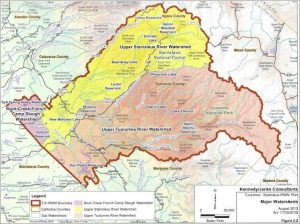If someone came up to you on the street and asked you, “What is a watershed?,” would you be able to tell them? Most people only know the general concept of watersheds, but do not know how watersheds impact our day-to-day lives. Think of a watershed like a bathtub: it is all the water, rain, and snow that drains to the same location, like a stream, lake, or wetland. This includes both surface water and groundwater. Watersheds have no size limit and do not follow county, city or district boundaries, nor do they follow distinctions between public or private lands. They can be small like the Upper Tuolumne River watershed (1,900 square miles), or gigantic, like the Mississippi River watershed (1.2 million square miles). It is important to know that our daily lives are often impacted and dependent on watersheds and, often times, what we do in our daily lives can affect the health of watersheds. They provide more than just the water we drink. They provide us with places to go fishing, swimming, and boating. Watersheds support diverse flora and fauna. Our economy, including agriculture and hydropower generation, depends on a healthy watershed.
Here in Tuolumne County, we are a part of two watersheds: the Upper Stanislaus River and Upper Tuolumne River. Being located in the headwaters of the Sierra, there are relatively few up-stream activities that may pollute our streams, as compared to downstream areas; as such, we have the benefit of having relatively clean water within our watersheds. However, impacts to water quality can occur from stormwater runoff.
Water that does not infiltrate into the ground is called stormwater. Many people have the misconception that the water that flows into storm drains gets treated. For instance, stormwater in downtown Sonora may flow into storm drains which flow directly into creeks and streams and tributaries within the watershed. As stormwater flows, various pollutants are picked up along the way. Some of these pollutants include pet waste, oil from cars, pesticides, and litter. Our everyday lifestyles can potentially benefit or negatively impact our watersheds and those downstream from us.
Simple things that anyone can do to help our waterways at a minimal or no cost are to pick up pet waste and litter, compost kitchen waste, and check cars for leaks. These tasks help reduce stormwater pollution from impacting our watershed. More in-depth best management practices include installing rain tanks, greywater systems, and native landscapes. It is up to us to help protect the health of our watersheds.
The Tuolumne County Resource Conservation District is a a non-regulatory Special District set up to promote Natural Resource Conservation in Tuolumne County. We work with individuals, landowners, growers, ranchers, public agencies, non-profit organizations and corporations to accomplish our goals. Some of our goals are to improve water quality, availability and storage as a result of practices implemented. Educating and working with community groups, schools and cooperative extension, like Master Gardeners, is key to keeping our watersheds healthy.
If you would like more information about the Tuolumne County Resource Conservation District, visit tcrcd.org.
Carolyn Lanza works for The Tuolumne County Resource Conservation district and this article was also edited by Francie McGowan, a University of California Cooperative Extension Master Gardener of Tuolumne County.


